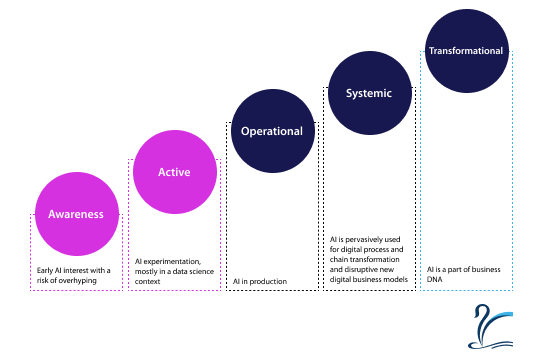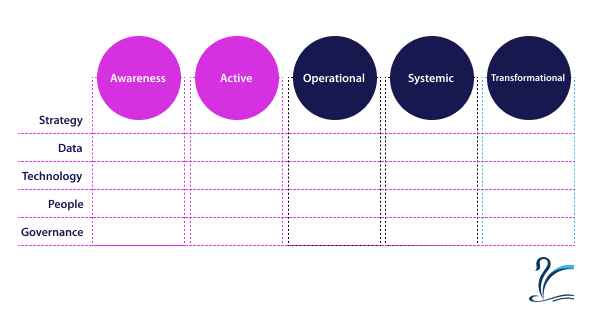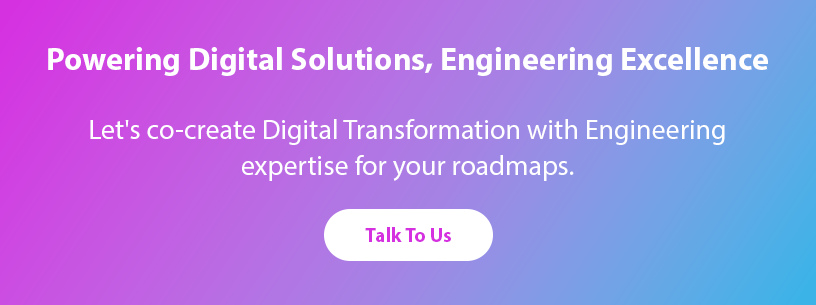To successfully implement the potential of AI, businesses need to have a structured process to fully take advantage of it. The AI Maturity Model serves as a valuable framework, allowing any organization to assess their current level of organizational maturity in AI adoption and identify the necessary steps to evolve into an “AI-driven” enterprise. The initial phase in the journey toward becoming an AI-driven business involves gaining a comprehensive understanding of the prerequisites.
In this article, we will delve into the five distinct stages outlined within the AI maturity framework and explore strategies for their implementation to achieve your success. Additionally, we will address common challenges associated with AI adoption and provide insights on how to refine your AI strategy and applications for maximum maturity.
The Motivation for AI Adoption
Organizations are increasingly exploring the integration of AI to augment their existing applications and streamline operational processes. Artificial intelligence holds the potential to automate decision-making, unearth actionable insights, and effectively categorize intricate data. While human involvement and investment will continue to play a pivotal role, AI empowers enterprises to expedite their operations.
To formulate a sound AI strategy, the first essential step involves evaluating your organization’s position within the AI maturity framework. This framework, also referred to as a model, serves as a valuable tool for pinpointing your organization’s position on the growth trajectory. This data provides a foundation for informed discussions with management and lays the groundwork for strategic decision-making.
Irrespective of your organization’s current AI maturity level, it is imperative to cultivate adaptable strategies that allow ample room for experimentation and growth.
Understanding the AI Maturity Model
An AI maturity model serves as a structured framework for organizations to evaluate their existing AI readiness and capabilities. It equips organizations with valuable and actionable insights to effectively prioritize investments in AI technologies, skills, and processes essential for the development, management, and maintenance of AI-based systems. Furthermore, it aids in identifying and mitigating potential risks associated with the deployment and utilization of AI.
You can discover the answers through Cygnet Free AI Maturity Assessment Audit! In today’s data-driven landscape, comprehending your organization’s data and AI maturity is paramount for achieving success. Whether your objective is to enhance decision-making, streamline operations, or foster innovation, understanding your data capabilities stands as the foundational first step.
Explore the integration of data-driven insights into your business processes to unlock greater value harnessing the potential of AI.
The Significance of an AI Maturity Model
When contemplating the integration of AI within your organization, it’s crucial to bear in mind two fundamental principles: not every task necessitates automation, and the true value of automation often emerges over the long term. Without the implementation of automation, the sole avenue for growth typically involves expanding your workforce through additional team members.
Machine learning algorithms, on the other hand, have revolutionized data processing capabilities in ways previously deemed unattainable. While mathematical principles have existed for years, the viability of these techniques was hampered by the lack of pertinent data and computational power.
The Five Stages of AI Maturity
In each dimension, a business can be in a different maturity stage.

According to Gartner, AI maturity can be classified into five distinct stages:
1. Awareness:
Organizations in this stage possess knowledge about AI but have not yet taken significant action.
They may discuss AI and have ideas but lack concrete strategies for implementation.
Data analysis is primarily manual, without intelligent tools or advanced data storage methods.
2. Active:
Most organizations fall into this category.
They are beginning to explore AI, transitioning from general awareness to specific questions about how AI can address their challenges or opportunities.
Raw data is often stored in fragmented systems, and decision-making is typically not data-driven.
3. Operational:
Companies at this stage have integrated machine learning into their day-to-day operations.
They maintain models, establish data pipelines, and have a team of ML engineers.
ML infrastructure is in place and ML aids in information processing tasks.
However, a central AI platform is not yet established, and AI capabilities are limited to operational levels.
4. Systemic:
Organizations at this level are leveraging AI to disrupt traditional business models.
AI is applied across various company functions and integrated into existing products, services, and processes.
Rules for AI model governance are defined and adhered to.
AI plays a central role in decision-making and is centrally managed.
5. Transformational:
- The highest stage of AI maturity, yet the least common.
- Organizations here use ML extensively and intentionally, often as a unique value proposition for customers.
- AI is embedded in the business model, corporate strategy, and various aspects of the organization.
- High priority is given to data, which is both a raw material and a product.
- Compliance with regulatory and ethical standards is a top priority.
- AI solutions are centrally managed in the organization’s AI platform.
- This stage represents the full potential of AI’s impact on business and society, where AI transforms operations, creates value, and addresses complex challenges.

At the transformational stage, companies work smarter with AI, operate more sustainably, and drive significant societal value. Although the specifics of this stage are still actively defined by data scientists and experts, it holds the promise of augmented human intelligence and collective intelligence between humans and machines, making it a pivotal phase in AI maturity.
Next Steps?
Are you fully leveraging your data and AI resources? Discover the answer with our Free Data and AI Maturity Assessment! In today’s data-centric world, comprehending your organization’s data and AI maturity is crucial for achieving success. Whether your goal is to enhance decision-making, streamline operations, or foster innovation, understanding your data capabilities is the first step.
Discover how to integrate data-driven insights into your business processes to unlock greater value with the power of AI.
Once the organization’s AI maturity level has been identified, the next question is: how to increase it? It takes three stages to implement the outcome to boost your AI maturity.
Today, most companies fall under the Awareness stage – their businesses only benefit a bit from artificial intelligence. At the same time, a few companies are in stage five, and few are both ready and can integrate AI through every one of their processes.
How Adopting AI Can Increase Business Value
The adoption of artificial intelligence should not be a mere response to industry hype; rather, it should strategically and measurably enhance business value. Key questions to consider include:
- What decisions does my company routinely make?
- What data does my company actively collect?
AI proves its worth when aiding data-driven decision-making. The journey to AI adoption comprises two essential steps: assessing current practices and exploring new decisions that can elevate overall company value.
Optimal results are achieved when you already have relevant data at your disposal and require critical decision-making. If you possess the necessary data, consider the following questions:
- What specific decisions can be derived from this data?
- What additional data is required to inform these decisions?
- How can you transition day-to-day activities into data-driven decisions?
Conclusion
While employing AI in applications, it’s imperative to focus on AI maturity goals to:
- Ensure the delivery of value to your clients.
- Select the appropriate level of technological sophistication.
- Establish trustworthiness and ease of use for targeted line-of-business users.
- Implement an AI operating model to manage deployed AI, alongside robust data management and governance practices.
Though AI is still in its early stages, numerous studies underscore its potential to reduce costs, enhance efficiency, and contribute to bottom-line profitability. AI’s applications span from scheduling maintenance for factory floors to targeting the right products to potential buyers and improving sales closure rates.
If your organization is ready to explore how we can support your AI journey, consider conducting a comprehensive AI maturity assessment.










